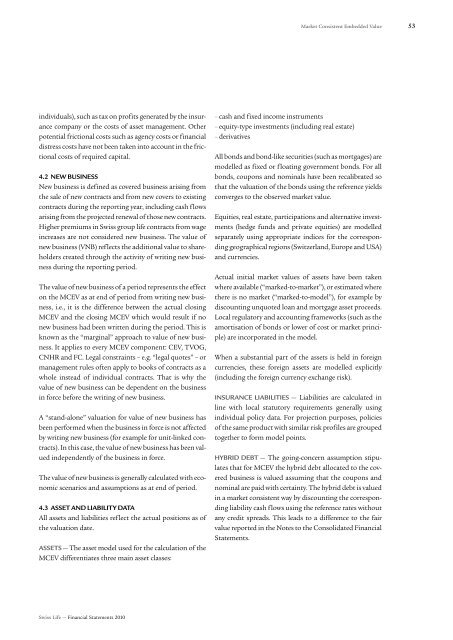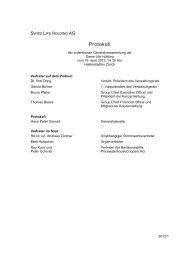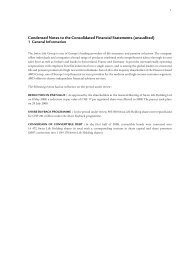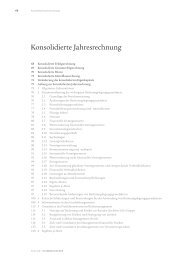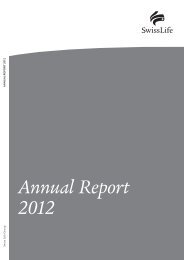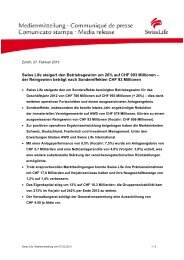Market Consistent Embedded Value (MCEV) - Swiss Life - Online ...
Market Consistent Embedded Value (MCEV) - Swiss Life - Online ...
Market Consistent Embedded Value (MCEV) - Swiss Life - Online ...
- No tags were found...
Create successful ePaper yourself
Turn your PDF publications into a flip-book with our unique Google optimized e-Paper software.
<strong>Market</strong> <strong>Consistent</strong> <strong>Embedded</strong> <strong>Value</strong>53individuals), such as tax on profits generated by the insurancecompany or the costs of asset management. Otherpotential frictional costs such as agency costs or financialdistress costs have not been taken into account in the frictionalcosts of required capital.4.2 NEW BUSINESSNew business is defined as covered business arising fromthe sale of new contracts and from new covers to existingcontracts during the reporting year, including cash flowsarising from the projected renewal of those new contracts.Higher premiums in <strong>Swiss</strong> group life contracts from wageincreases are not considered new business. The value ofnew business (VNB) reflects the additional value to shareholderscreated through the activity of writing new businessduring the reporting period.The value of new business of a period represents the effecton the <strong>MCEV</strong> as at end of period from writing new business,i.e., it is the difference between the actual closing<strong>MCEV</strong> and the closing <strong>MCEV</strong> which would result if nonew business had been written during the period. This isknown as the “marginal” approach to value of new business.It applies to every <strong>MCEV</strong> component: CEV, TVOG,CNHR and FC. Legal constraints – e.g. “legal quotes” – ormanagement rules often apply to books of contracts as awhole instead of individual contracts. That is why thevalue of new business can be dependent on the businessin force before the writing of new business.A “stand-alone” valuation for value of new business hasbeen performed when the business in force is not affectedby writing new business (for example for unit-linked contracts).In this case, the value of new business has been valuedindependently of the business in force.The value of new business is generally calculated with economicscenarios and assumptions as at end of period.4.3 ASSET AND LIABILITY DATAAll assets and liabilities reflect the actual positions as ofthe valuation date.ASSETS — The asset model used for the calculation of the<strong>MCEV</strong> differentiates three main asset classes:– cash and fixed income instruments– equity-type investments (including real estate)– derivativesAll bonds and bond-like securities (such as mortgages) aremodelled as fixed or floating government bonds. For allbonds, coupons and nominals have been recalibrated sothat the valuation of the bonds using the reference yieldsconverges to the observed market value.Equities, real estate, participations and alternative investments(hedge funds and private equities) are modelledseparately using appropriate indices for the correspondinggeographical regions (Switzerland, Europe and USA)and currencies.Actual initial market values of assets have been takenwhere available (“marked-to-market”), or estimated wherethere is no market (“marked-to-model”), for example bydiscounting unquoted loan and mortgage asset proceeds.Local regulatory and accounting frameworks (such as theamortisation of bonds or lower of cost or market principle)are incorporated in the model.When a substantial part of the assets is held in foreigncurrencies, these foreign assets are modelled explicitly(including the foreign currency exchange risk).INSURANCE LIABILITIES — Liabilities are calculated inline with local statutory requirements generally usingindividual policy data. For projection purposes, policiesof the same product with similar risk profiles are groupedtogether to form model points.HYBRID DEBT — The going-concern assumption stipulatesthat for <strong>MCEV</strong> the hybrid debt allocated to the coveredbusiness is valued assuming that the coupons andnominal are paid with certainty. The hybrid debt is valuedin a market consistent way by discounting the correspondingliability cash flows using the reference rates withoutany credit spreads. This leads to a difference to the fairvalue reported in the Notes to the Consolidated FinancialStatements.<strong>Swiss</strong> <strong>Life</strong> — Financial Statements 2010


